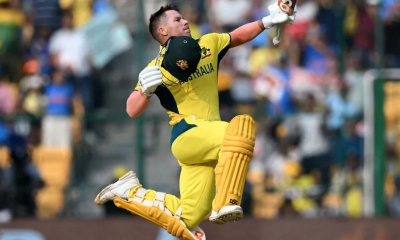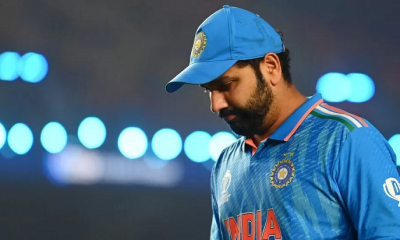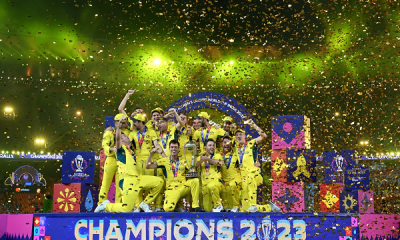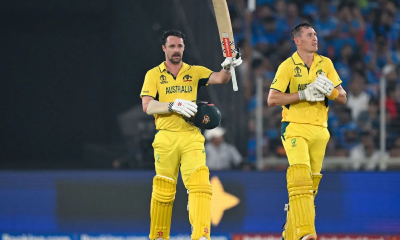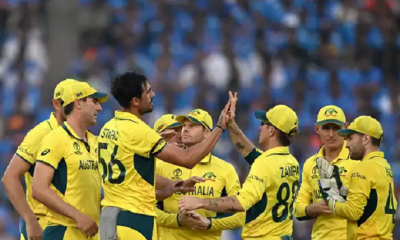Latest News
Marsh’s imperious 177* headlines Australia’s commanding win

Mitchell Marsh headlined Australia’s dominating win against Bangladesh in Pune on Saturday (November 11) as the Pat Cummins-led side ended the league stage of the World Cup with seven wins out of nine ahead of their semifinal clash against South Africa in Kolkata. Bangladesh came up with a collective effort with the bat, with Towhid Hridoy spearheading the effort with a 74, as they posted 306/8, their highest total in this World Cup. But it proved too little against Marsh’s imperious 177* off 132, which came in two century partnerships – 120 with David Warner (53) and 175* with Steve Smith (63*) – as Australia raced to the target with 8 wickets in hand and 5.2 overs to spare.
Travis Head hit a couple of boundaries before he dragged a delivery onto the stumps to give Taskin Ahmed a wicket in the third over. Bangladesh operated with Mahedi Hasan from the other end as they tried to apply some pressure with spin but Marsh ensured there was no stagnation as he hit three fours in an over off the spinner, followed by a boundary and a six off Taskin as well. After a watchful start, Warner also got into the act with two fours in an over off Nasum Ahmed and the left-arm spinner was also hit for a six by Marsh. Mahedi, meanwhile, bowled a couple of quiet overs as Australia moved to 58/1 after 10 overs.
Whenever Bangladesh tried to keep things tight, Marsh provided the release with timely boundaries. Mehidy Hasan was also on the receiving end as he was hit for a four and a six off the first two balls he bowled, and Marsh collected a four off Mustafizur Rahman as well en route to a 37-ball fifty. Warner was pacing his innings well at the other end, rotating the strike and managing fours from time to time, with his fourth boundary helping Australia reach the 100 run mark in the 15th over. Warner struck two more fours, off Nasum in the 19th over – the first one extended the partnership past 100 and the second helped the left-hander reach a 52-ball fifty. Warner, however, was early into a drive and was dismissed by Mustafizur. Najmul Hossain Shanto held on to the ball at mid on but lost control of it when he tried to throw, but the umpires did not check the legality of the catch.
Marsh continued confidently, creaming boundaries off the pace bowlers regularly as he entered the 80s and helped Australia past 150 in the 25th over. He quickly entered the 90s, striking a six and a four off Mehidy, and then got to 100 off 87 balls with a single off Nasum in the 31st over. In the same over, Smith got going with a four and a six while Marsh, after going a bit quiet as he approached three figures, got back to his aggressive ways with sixes off Mehidy and Mustafizur. Marsh was being hampered by cramps, limping between the wickets, but the boundaries did not stop as he struck a couple of them in Nasum’s over, and Smith also hit a four after playing out a maiden from Mustafizur.
The pair brought up a century stand in quick time and Smith got into the 40s, with Bangladesh not able to do much despite all their bowling changes. Marsh was charging towards 150 at the other end, adding to his fours and sixes tally, as Australia crossed 250 in the 39th over. Marsh reached 150 in style, scoring two successive fours off Mustafizur to get to the milestone off 117 deliveries. Smith then got to his 11th World Cup fifty-plus score, equalling Ricky Ponting and Warner, while Marsh continued to toy with the Bangladesh bowling with more maximums. He finished with 17 fours and nine sixes but it was Smith’s fourth boundary that sealed Australia’s commanding win.
Earlier, after Australia opted to bowl, Josh Hazlewood kept it tight at the start but Cummins was a bit erratic, conceding plenty of wides. The Bangladesh openers overcame a cautious start to score regular boundaries as they put on a good partnership. Tanzid Hasan and Litton Das managed 62 in the first powerplay without losing any wicket – their second highest score in this period in this World Cup, which was also the second highest conceded by Australia and also the fourth time they went wicketless. The stand finally came to an end in the 12th over when Sean Abbott had Tanzid fending a short ball back to him. Australia went ahead and tried more short balls but Najmul was prepared as he cracked a couple of pulls off Marsh for boundaries. But the well-set Litton departed soon after, chipping a catch to long on to give Adam Zampa a wicket.
There was an immediate transfer of pressure with Zampa and Head bowling well in tandem but Hridoy eased some of it with a six over midwicket off the legspinner. Najmul and Hridoy then came down the track and unsettled the lengths of Marcus Stoinis, collecting boundaries as a result. Hridoy also took the attack to Head, striking a four and a six, as Bangladesh reached 161/2 at the halfway stage, with the third wicket pair extending their partnership past 50. But it was an abrupt end to the association as a good bit of fielding from Marnus Labuschagne resulted in Najmul being run out for 45. Mahmudullah came out with a positive intent, dealing in sixes, before Labuschagne effected a run out again.
Shortly after Hridoy got to his first World Cup fifty, Mushfiqur Rahim sent an Abbott delivery over the midwicket fence as Bangladesh went past 250 in the 42nd over. But Rahim’s stay was cut short by Zampa, who surpassed Brad Hogg’s 21 wickets in 2007 to register the highest tally by an Australian spinner in a World Cup and finished with figures of 2 for 32. Cummins, meanwhile, had an expensive outing as both Hridoy and Mehidy struck plenty of boundaries. But Hridoy’s outing ended when he hit a full toss from Stoinis to Labuschagne at deep midwicket. A handy 29 from Mehidy helped Bangladesh past 300 but Australia did well in the death, conceding only one boundary in the last four overs.
Brief scores:
Bangladesh 306/8 in 50 overs (Tanzid Hasan 36, Litton Das 36, Nalimul Hossain Shanto 45, Towhid Hridoy 74, Mahmudullah 32, Mushfiqr Rahim 21, Mehidy Hassan Miraz 29; Adam Zampa 2-32, Sean Abbott 2-61) lost to Australia 307/2 in 44.4 overs (Mitchell Marsh 177*, Steve Smith 63*, David Warner 53) by 8 wickets.
Latest News
IPL 2025 to resume on May 17, final to be played on June 3

IPL 2025 will resume on May 17 and end on June 3, as per the revised schedule announced by the BCCI on Monday night.
The remainder of the tournament, which was suspended on May 9 for a week due to cross-border tensions between India and Pakistan, will be played at six venues: Bengaluru, Jaipur, Delhi, Lucknow, Mumbai and Ahmedabad. The venues for the playoffs will be announced later, but the matches will be played on the following dates: Qualifier 1 on May 29, the Eliminator on May 30, Qualifier 2 on June 1 and the final on June 3. A total of 17 matches will be played after the resumption, with two double-headers, both of which will be played on Sundays.
The revised schedule features 13 league games and the four playoff matches. This means that the Punjab Kings (PBKS) vs Delhi Capitals (DC) game, which was called off midway through the first innings on May 8 in Dharamsala, will be played again, on May 24 in Jaipur, which will be the temporary home base for PBKS. Two days later, PBKS will play against Mumbai Indians (MI), a match they were originally meant to play in their second home base of Dharamsala on May 11. The match that will restart the tournament on May 17 will be played between Royal Challengers Bengaluru (RCB) and Kolkata Knight Riders (KKR) in Bengaluru.
On the first of the two double-header days, Rajasthan Royals (RR) will meet PBKS in the day game (3.30pm IST) on May 18 and DC will take on Gujarat Titans (GT) in the evening (7.30pm IST). The next Sunday – May 25 – will see GT take on Chennai Super Kings (CSK) in the day game in Ahmedabad and Sunrisers Hyderabad (SRH) meet KKR in Delhi at 7.30pm IST. The last league game will be between Lucknow Super Giants (LSG) and RCB on May 27 in Lucknow.
The change in venues also means that three teams – PBKS, CSK and SRH – won’t get to play on their original home grounds anymore. With CSK and SRH out of the playoffs race, PBKS will count themselves unlucky to be playing two of their home matches at a neutral venue. With 15 points from 11 matches, PBKS were third on the points table before the tournament was suspended.
The official release said the BCCI held “extensive consultations with government and security agencies, and with all the key stakeholders” before finalising the resumption of the tournament.
The delayed finish of the IPL, which was originally scheduled to end on May 25 in Kolkata, means it will now coincide with the entire ODI series between England and West Indies starting on May 29 in Birmingham and ending on June 3 at The Oval. It will lead to a clash for Romario Shepherd (RCB), Shamar Joseph (LSG) and Sherfane Rutherford (GT), who have all been picked in the West Indies ODI squad. England have not named their squad yet but the players likely to be affected are Jos Buttler (GT), Phil Salt (RCB), Jacob Bethell (RCB), Liam Livingston (RCB), Will Jacks (MI) and Reece Topley (MI), depending on which teams make the playoffs.
The revised IPL schedule also squeezes the gap between the IPL final and the WTC final to just seven days, with Australia and South Africa set to contest the Test world title from June 11 at Lord’s. Both Australia and South Africa are scheduled to announce their squads on Tuesday. The players who are currently part of the IPL teams and are likely to be picked for the WTC final are Australia captain Pat Cummins and Travis Head (both SRH), Mitchell Starc and Tristan Stubbs (both DC), Josh Hazlewood (RCB), Marco Jansen and Josh Inglis (both PBKS), Aiden Markram (LSG), Kagiso Rabada (GT), Ryan Rickelton (MI) and Kwena Mphaka (RR).
The revised schedule will also potentially impact the India A tour of England, which is scheduled to begin from May 30, for two unofficial Tests in Canterbury and Northampton. Several fringe India players, some of whom are likely to be part of the India squad for the five-Test series starting on June 20 in England, will now be part of the IPL when the A matches begin.
For now, the biggest challenge for the 10 IPL franchises will be to re-assemble their squads and bring back overseas players and support-staff members who had begun flying back home over the weekend. The team that could find it easiest to get back together will be GT, currently on top of the table, who had seen only two of their overseas players fly back: Buttler and Gerald Coetzee. The rest of their squad was continuing to train in Ahmedabad. MI could also benefit from the revised schedule, as their first game is on May 21, four days after the tournament resumes.
Latest News
Modi addresses nation for first time since start of India-Pakistan strikes

India’s Prime Minister Narendra Modi has said his country will respond strongly to what he describes as a future “terrorist attack”, after four days of military exchanges with neighbouring Pakistan.
“This is not an era of war, but this is also not an era of terror,” Modi said in his first public address since days of intense shelling and aerial incursions, carried out by both sides, began.
These followed a militant attack in Indian-administered Kashmir that killed 26 people, for which India blamed a Pakistan-based group. Islamabad has strongly denied backing the group in question.
The US brokered ceasefire agreed between the nuclear-armed neighbours at the weekend appears to have held so far.
Business
Trump heads to Saudi Arabia eyeing more investment in US

With US President Donald Trump due to visit Gulf states this week, a key focus will be securing significant new investment for the US economy.
“President Trump wants the announcement [of more Gulf money for the US],” says economist Karen Young, a senior fellow at the Middle East Institute think tank.
“He wants to have a big poster in a meeting that describes where these investments might go. And some estimation of what they will do to the American economy in terms of job creation or his big push, of course, on domestic manufacturing.”
Trump is due to arrive in the Saudi capital, Riyadh, on Tuesday 13 May, to meet the country’s de facto leader Crown Prince Mohammed bin Salman.
Trump is then expected to attend a summit of Gulf leaders in the city on 14 May, before travelling to Qatar that same day, and then ending his three-day trip in the United Arab Emirates (UAE) on 15 May.
The economic importance of the region to Trump is highlighted by the fact that the visit to Saudi Arabia was due to be the first overseas trip of his second term in the White House. That was before the death of Pope Francis necessitated Trump attending his funeral in Rome towards the end of April.
Saudi Arabia was also the first country that Trump visited during his first term of office, going against the modern practise of US presidents to start with the UK, Canada or Mexico.

Securing new investments in the US from Gulf states, and particularly from their state-backed sovereign wealth funds, will help Trump to signal back home that his “America First” agenda is delivering results.
The presidential visit is drawing top Wall Street and Silicon Valley leaders to Saudi Arabia. A Saudi-US investment forum on 13 May in Riyadh will feature CEOs from BlackRock, Palantir, Citigroup, IBM, Qualcomm, Alphabet, and Franklin Templeton.
The push comes amid economic headwinds, as President Trump’s new import tariffs have significantly disrupted global trade, confidence, and the US economy itself. US economic output fell in the first three months of this year, its first fall in three years.
Back in January, Prince Mohammed said that Saudi Arabia would invest $600bn (£450bn) in the US over the next years. However, Trump has already said that he’d like that to rise to $ 1tn, including purchases of more US military equipment.
According to Ali Shihabi – a Saudi commentator and author, with close ties to the Saudi government – a number of economic agreements will be signed during the trip.
“These deals will further integrate the Saudi and US economies together, joint ventures in the kingdom, in the United States, procurements of American weapons and goods,” says Mr Shihabi.
Saudi Arabia’s sovereign wealth fund, the Public Investment fund (PIF), which controls assets worth $925bn, already has numerous investments in the US. These include Uber, gaming firm Electronic Arts, and electric car firm Lucid.
Meanwhile, the UAE has already committed to investing $1.4tn in the US over the next 10 years, in sectors such as AI, semiconductors, energy and manufacturing. This was announced by the White House in March after the UAE’s national security advisor, Sheikh Tahnoon bin Zayed Al Nahyan, met President Trump in Washington.
Yet Ms Young from the Middle East Institute says that the scale of these investments is not realistic in the short term. She instead says that they are long-term strategic moves, and that the figures should be taken “with a little bit of a grain of salt”.
Regarding specific deals that could be announced during Trump’s visit, it is widely reported that Saudi Arabia will agree to buy more than $100bn of US arms and other military items.
These are said to include missiles, radar systems and transport aircraft.
The US has been a longstanding arms supplier to Saudi Arabia, but in 2021 the then Biden administration stopped selling Riyadh offensive weapons, citing concerns about the country’s role in the war in neighbouring Yemen.
The 2018 killing of Saudi journalist Jamal Khashoggi was also widely reported to be a factor. A US report said that Prince Mohammed had approved the murder.
The Biden White House resumed the sale of these weapons last year. While it cited that the Saudis had stopped bombing Yemen, some commentators said that the US was seeking Saudi assistance to help end the conflict in Gaza and aid its future reconstruction.

Mr Shihabi says Saudi Arabia will be seeking assurances from the White House that the US will implement a “more efficient procurement system”, enabling the Gulf state to access ammunition and military equipment far more quickly and easily.
“The Trump administration is initiating procedures to facilitate those deals. So, it’s expected that this process will improve immediately,” he adds.
Artificial intelligence is the other topic that will dominate the agenda during Mr Trump’s visit. Talks are expected to centre on attracting greater Gulf investment into US tech firms, and boosting the region’s access to cutting-edge American semiconductors.
The UAE and Saudi Arabia have been investing billions of dollars into tech and AI sectors as try to diversify their economies away from oil.
The Emiratis, in particular, are keen to establish themselves as a global AI hub.
Last week, the Trump administration scrapped the Biden-era chip regulations that placed restrictions on exports of advanced US chips to more than 120 countries including the Gulf states.
The White House is expected to draft new rules that would potentially involve direct negotiations with countries like the UAE.
“For the UAE, this is absolutely essential,” says Ms Young. “They are aggressively building out their AI capacity. So, for them getting access to US technology is imperative to be the best.”
While much attention will be on Trump courting Gulf capital for the US, Saudi Arabia is equally focused on drawing American investment into its ambitious Vision 2030 program.
Led by giant construction projects, such as the building of a linear city called The Line, Vision 2030 is central to the Saudi government’s continuing efforts to diversify the country’s economy away from oil.
It also involves pouring resources into entertainment, tourism, mining and sports.
However, foreign direct investment into Saudi Arabia declined for a third straight year in 2024, reflecting persistent challenges in attracting overseas capital.
The fall in global oil prices since the start of the year has further strained Riyadh’s finances, increasing pressure to either raise debt or cut spending to sustain its development goals.
Oil prices tumbled to a four-year low amid growing concerns that a trade war could dampen global economic growth.
The decline was further fuelled by the group of oil producing nations, Opec+, announcing plans to increase output.
Saudi Arabia is part of that group, and some commentators said that the rise was in part a desire to please Trump who has called for lower oil prices.
Other analysts said the reason was more that Opec+ remains confident that the global economy is growing.
The US-Saudi Business Council, is an organisation that aims to boost trade ties between the two countries.
It is hoping that Trump’s visit will push American businesses to explore more opportunities in Saudi Arabia, especially in sectors like AI, healthcare and education.
“The Saudi government is looking heavily to invest in these sectors. There is a very big appetite for Saudi companies to collaborate with American companies,” Hutham Al Jalal, who heads the Riyadh office for the organisation, tells the BBC.
Saudi officials are said to be confident that some deals in these sectors will be secured during Trump’s visit.
For Saudi Arabia, Trump’s visit is about strengthening ties with their longest-standing Western ally – a relationship that grew strained during the Biden years. For President Trump, it is about landing investment deals that can be framed as a win for his economic agenda.
“President Trump is looking for a headline of big investments in America, and he will get that from this trip,” adds Mr Shihabi.
[BBC]
-

 Latest News6 days ago
Latest News6 days agoNPP win Maharagama Urban Council
-

 Features2 days ago
Features2 days agoSAITM Graduates Overcome Adversity, Excel Despite Challenges
-

 Business5 days ago
Business5 days agoJohn Keells Properties and MullenLowe unveil “Minutes Away”
-

 Sports2 days ago
Sports2 days agoASBC Asian U22 and Youth Boxing Championships from Monday
-

 News2 days ago
News2 days agoDestined to be pope:Brother says Leo XIV always wanted to be a priest
-

 Foreign News3 days ago
Foreign News3 days agoMexico sues Google over ‘Gulf of America’ name change
-

 Opinion5 days ago
Opinion5 days agoRatmalana: An international airport without modern navigational and landing aids
-

 Business6 days ago
Business6 days agoNDB Bank partners with Bishop’s College to launch NDB Pixel awareness



